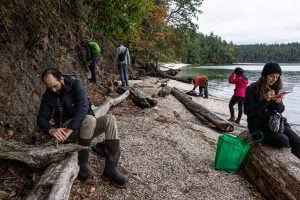Citizen scientists Nick Bowman, Rebecca Barrett, and Hamish Tweed fist bump before descending for a deep dive (Photo: Perpetuum Films / Moonless Oasis)
On the citizen scientists advocating for the sponges
Slaco: I feel like we kind of lucked out — we didn’t really struggle with directing them too much. Bryce and I made the decision that we didn’t necessarily want to make the story a scientific story about why sponges are important; we wanted to tell the story through the eyes of these people, why they think it’s important and why they’re so passionate to spend their time and money risking their lives to explore and protect these things. I feel that hopefully will help people, who aren’t necessarily interested in the ocean, relate to that.
We basically found out that if you’re going to go out and do this stuff, you’re going to need a character … like Glenn mapped the bottom of Howe Sound for 10 years by himself. That’s not the most normal thing to do as a hobby! It’s amazing. It’s been super helpful. It’s a huge contribution to the world. But, you know, I think someone who put that on themselves and builds homemade drop cameras and homemade technical instruments is just, by their nature, going to be an interesting person. And so all of the people that do this stuff are relatively interesting people. Jeff was great because I don’t think Jeff can not be Jeff. It doesn’t matter if the camera’s on him or not, he’s exactly the same person. And so that’s the best you can ask for, I think.
Zimmerman: It kind of took us a little bit, too, to understand just how dangerous it was [for them to go down there] and just the fact that they are at life’s edge at all times — it’s like life or death. And these people aren’t doing this for a claim or for fame or for recognition persay; they’re doing it for the sponge.
On what they took away from making the film
Zimmerman: The biggest takeaway for me is probably that you can go out and do something like this and make a difference in the world just by sheer force of will and perseverance. That whole team, that’s all they do. And over time, you know, that group of people care enough and they have made a difference in being able to protect these areas. I don’t know how much people are aware of what kind of work is being done like this. But if you care about the world you just go out there and make a difference. You’ll don’t have to wait for someone else to do it or to go through some sort of big organization. You can literally find something in your backyard and protect it.
Slaco: Building off what Bryce said, obviously this is a very B.C. unique thing, but, you know, every pocket of the world has something special about it. And you can hopefully relate what’s happening here to what is in your backyard. It can sometimes feel futile, everything that’s happening in the world. But the fact that these people have persevered and really, you know, every weekend, some times week day, going out there. Obviously, they enjoy what they’re doing but just continuously doing that, I think that’s really powerful.
On their glass sponge subjects and communicating that fascination
Zimmerman: There’s this quote that I always remember that “wonder is the absence of interpretation.” And it’s kind of like that moment when we first were first learning about the sponges — you always have to come back to and understand that feeling. And for us, you know, we were learning that [the sponges are] just living dinosaurs, underwater. There’s a story of the German researcher who was studying the fossilized remains of the glass sponges when they were discovered off the coast of B.C. I guess he just wept; he just cried because clearly it’s like someone had opened up a cave and found this lost world. That’s basically what we have here. And I think that part of it is what we’re trying to communicate — just how wild and how special this is, because that’s not normal to have this. There’s not really any other place in the world that has something similar.








